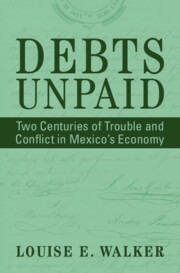Refine search
Actions for selected content:
26944 results in Economic history
Contents
-
- Book:
- Institutional Change and Property Rights before the Industrial Revolution
- Published online:
- 23 October 2025
- Print publication:
- 06 November 2025, pp vii-vii
-
- Chapter
- Export citation
Conclusion
-
- Book:
- Institutional Change and Property Rights before the Industrial Revolution
- Published online:
- 23 October 2025
- Print publication:
- 06 November 2025, pp 229-234
-
- Chapter
- Export citation
9 - Wardship and the Wars of the Three Kingdoms
-
- Book:
- Institutional Change and Property Rights before the Industrial Revolution
- Published online:
- 23 October 2025
- Print publication:
- 06 November 2025, pp 199-228
-
- Chapter
- Export citation
Abbreviations
-
- Book:
- Institutional Change and Property Rights before the Industrial Revolution
- Published online:
- 23 October 2025
- Print publication:
- 06 November 2025, pp xi-xii
-
- Chapter
- Export citation
Preface
-
- Book:
- Institutional Change and Property Rights before the Industrial Revolution
- Published online:
- 23 October 2025
- Print publication:
- 06 November 2025, pp ix-x
-
- Chapter
- Export citation
6 - Law and the Court of Wards
-
- Book:
- Institutional Change and Property Rights before the Industrial Revolution
- Published online:
- 23 October 2025
- Print publication:
- 06 November 2025, pp 150-165
-
- Chapter
- Export citation
Bibliography
-
- Book:
- Institutional Change and Property Rights before the Industrial Revolution
- Published online:
- 23 October 2025
- Print publication:
- 06 November 2025, pp 235-253
-
- Chapter
- Export citation
Tables and Figures
-
- Book:
- Institutional Change and Property Rights before the Industrial Revolution
- Published online:
- 23 October 2025
- Print publication:
- 06 November 2025, pp viii-viii
-
- Chapter
- Export citation
The role played by the European Investment Bank in Spain
-
- Journal:
- Revista de Historia Economica - Journal of Iberian and Latin American Economic History , First View
- Published online by Cambridge University Press:
- 05 November 2025, pp. 1-29
-
- Article
- Export citation

Debts Unpaid
- Two Centuries of Trouble and Conflict in Mexico's Economy
-
- Published online:
- 04 November 2025
- Print publication:
- 20 November 2025
The Manila correspondencia and the institutional underpinnings of the trans-Pacific silver trade in the long eighteenth century
-
- Journal:
- Revista de Historia Economica - Journal of Iberian and Latin American Economic History , First View
- Published online by Cambridge University Press:
- 03 November 2025, pp. 1-23
-
- Article
-
- You have access
- Open access
- HTML
- Export citation

Self-Made
- The Stories That Forged an American Myth
-
- Published online:
- 30 October 2025
- Print publication:
- 30 October 2025
Tables
-
- Book:
- The Capitalist Self
- Published online:
- 12 October 2025
- Print publication:
- 30 October 2025, pp xi-xii
-
- Chapter
- Export citation
4 - Early Panics
-
- Book:
- Before the Fed
- Published online:
- 16 October 2025
- Print publication:
- 30 October 2025, pp 45-62
-
- Chapter
- Export citation
Technical Appendix 2.2. - Loan Certificates: A Balance Sheet Analysis
-
- Book:
- Before the Fed
- Published online:
- 16 October 2025
- Print publication:
- 30 October 2025, pp 211-218
-
- Chapter
- Export citation
Dedication
-
- Book:
- Before the Fed
- Published online:
- 16 October 2025
- Print publication:
- 30 October 2025, pp ix-x
-
- Chapter
- Export citation
Select Bibliography
-
- Book:
- The Capitalist Self
- Published online:
- 12 October 2025
- Print publication:
- 30 October 2025, pp 426-440
-
- Chapter
- Export citation
5 - Forging Origins in Antebellum Stories
-
- Book:
- Self-Made
- Published online:
- 30 October 2025
- Print publication:
- 30 October 2025, pp 103-127
-
- Chapter
- Export citation
Technical Appendix 3.1. - Morgan’s Routine Business Syndicates
-
- Book:
- Before the Fed
- Published online:
- 16 October 2025
- Print publication:
- 30 October 2025, pp 219-235
-
- Chapter
- Export citation
Introduction
-
- Book:
- Self-Made
- Published online:
- 30 October 2025
- Print publication:
- 30 October 2025, pp 1-9
-
- Chapter
- Export citation
